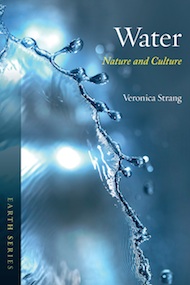By David L. Kirchman
Books with single word titles (see Cod or Salt) often focus relentlessly on a seemingly narrow topic. Not this book. Veronica Strang, a cultural anthropologist at Durham University in England, has written a meandering, all-encompassing account of an essential liquid and society’s relationship with it. In the Introduction, she acknowledges that she cannot “distil” down into one slim book the “vast and complex oceans” of information about the topic. Rather, Strang’s goal is to get us to think differently about water and our relationship to it.
The first chapter, “Water on Earth,” begins with the origin of water on our planet. Some scientists believe all of the water on earth came from asteroids bombarding our planet soon after its formation over four billion years ago. Rather than from the sky, Greek philosophers thought all water came from a massive subterranean reservoir, dubbed Tartarus by Aristotle. In addition to water beneath the earth, the ancient Greeks believed that the earth was surrounded by Okeanus, a swirling stream of water. Early Egyptians and Chinese also used aquatic terms to describe the Milky Way. Quoting Ivan Illich, Strang suggests “water has a nearly unlimited ability to carry metaphors.”
That first chapter has 16 of the book’s 107 illustrations, most of which are in color, printed on thick glossy paper. The illustrations are as eclectic as the text. This chapter has a stunning aerial picture of Rio Tino in Spain, which earns its name by having high concentrations of blood-red iron minerals. That picture is followed by a Leonardo da Vinci sketch of flowing water. The chapter and elsewhere in the book has many pictures of scenery and art from New Zealand and Australia, evidence of the time Spang spent in both countries. She uses many examples from the Antipodes and Asia to augment those more predictably from Europe and North America.
The rest of book continues to be a bricolage of history and anthropology and religion and, well, everything else; water touches on just about all human endeavors. The chapter “Redirections” provides some examples. Here Spang mentions that Dionysius of Halicarnassus in the first century BCE argued that two (aqueducts and sewers) of the three most significant works of Rome involved water (the third being paved roads). Spang then segues to a discussion about harnessing water for power and transportation and how, in spite of advances in ship technology and the ocean sciences, seafaring remained dangerous and the oceans filled with monsters. Herman Melville’s Moby-Dick is discussed briefly, which leads to a short discourse on whaling and how it illustrates the mastery of society over the seas. Some of this jumping from topic to topic works better than others.
Spang starts to drop the neutral stance of the academician when discussing some of the problems now affecting water and its water supply in many countries, including parts of the US. She starts by pointing out the problems with dams, which have drowned archaeological and historic sites, displaced millions of people, and disrupted ecosystems. Perhaps more ominous are the conflicts, current and future, over the supply of water around the world, from drought-stricken California to the Middle East. Pakistan is facing a water shortage in its near future as flow from the Indus River lessens due to decreasing input from melting glaciers in the Himalayas. Consequently, according to Spang, about half of the $7.5 billion dollars in US aid to Pakistan is directed to water-related projects.
The start of a general solution to these problems is hinted at with the concluding words of the book. Spang argues for replacing “utilitarian reduction” with a more holistic approach exemplified by water. Only then can we “think and act connectively and collaboratively.” The alternative is implied by the last illustration in the book: a poster advertising cruises from Southampton to New York on the Titanic.
David L. Kirchman (ΦBK, Lawrence University, 1976) is the Maxwell P. and Mildred H. Harrington Professor Marine Biosciences at the University of Delaware and a resident member of the Alpha of Delaware chapter of Phi Beta Kappa.




